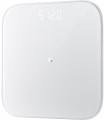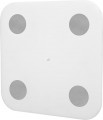Minimum measurement weight
The minimum weight limit at which the scale's readings must align with the specified margin of error is referred to as the minimum load parameter. While theoretically the scale can display measurements below this threshold, the reliability of results can't be guaranteed due to the extremely low load on the sensors in the device's design. The minimum load requirement is primarily determined by the type and intended use of the scales. For instance, kitchen models typically have a range of a few grams, floor scales start at a couple of kilograms, and commodity warehouse scales might begin at 10-15 kg.
Units of measurement
Weights are able to keep records in various units of measurement, while accounting can be done both by mass and by volume. Among the most common units of measurement, we highlight the following.
— Grams (g) — a unit of weight that belongs to the metric system. Grams are used in desktop kitchen scales.
— Kilograms (kg) — a unit of weight that belongs to the metric system. Kilograms are used in floor weighing equipment.
— Pounds (lb:oz) is a common unit of weight used in some countries in Europe, as well as in the United States. 1 pound can be equated to 0.45 kilograms.
— Milliliters (ml) — a unit of volume that belongs to the metric system. Some models of scales are able to determine the volume of milk and water based on mass.
— Ounces (fl'oz) is a unit of volume used in English-speaking countries. 1 US ounce is equivalent to 30 mL.
— Stones (st) is the British unit of weight. Stones are used to take into account the mass of the human body, so this measurement system is found in floor household and specialized diagnostic scales. 1 stone can be equated to 6.35 kilograms.
Measurements
—
Height measurement. The ability to measure height is a common feature in scales designed for children. These scales typically have a measuring device integrated into their design. This device can vary, ranging from a simple measuring tape to movable partitions that adjust according to the child's growth. Measuring height alongside weight is convenient for assessing a child's development. Some floor scales for adults also offer this function, using innovative methods. For example, in certain models, a wireless remote control acts as a measuring ruler, raised to the head's level for measurement. Height measurement often combines with calculating body mass index.
—
Measurement of % of adipose tissue. Measurement of the amount of adipose tissue in the body. This function is especially useful for people with a dense physique, it allows you to quite accurately determine what caused a lot of weight — obesity or general characteristics of the body. Note that in this case we are talking about the amount of all types of adipose tissue; separately, measurement of the amount of visceral fat may be provided, see below about it.
—
Calculation of the level of visceral fat. Measurement of visceral fat is the ability to gauge the quantity of adipose tissue encircling internal organs like the stomach, intestines, and kidneys. While some visceral fat is essential for or
...gan protection and bodily function, excessive amounts can lead to severe health issues. This feature identifies the proportion of adipose tissue categorized as visceral fat, aiming for it to constitute less than 10-15% of the total fat content.
— Measurement of % body fluid. Measurement of total body water is the ability to assess the overall water content within the body. Water is essential for bodily functions; its deficiency can result in consequences ranging from weakness to severe illnesses. However, excessive water retention can lead to swelling. It's important to mention that any organism lacking sufficient water is prone to dehydration. Swelling, on the other hand, signals inefficiencies in specific organs like the heart or kidneys. This can be due to diseases or temporary factors like increased exercise, heat exposure, or alcohol consumption. Notably, the optimal water content varies among individuals based on factors such as gender, age, health, and physique. In-depth information on this, along with methods for establishing such norms, can be found in specialized resources.
— Measurement of % muscle mass. The capability to measure total muscle mass in the body is a crucial parameter for assessing physique characteristics. This function holds particular significance for bodybuilders aiming to enhance their muscle mass. Effective muscle growth necessitates not only rigorous training but also a well-structured nutrition plan, abundant in carbohydrates. Poor dietary planning can lead to excess fat accumulation instead of muscle development. Regular muscle mass measurements enable ongoing trend assessment and prompt adjustments to the mass gain program when needed.
— Measurement of % bone mass. The ability to measure total bone mass within the body is a significant parameter for evaluating an individual's physique. Bone densities can vary among individuals, and increased body weight might be attributed to bone tissue rather than fat. Notably, bone weight and composition change less rapidly compared to muscles and body fat. Consequently, this function primarily serves for initial assessments of body characteristics.
— Calculation of basal metabolic rate(BMR). The feature to compute basal metabolism is the capacity to calculate the minimal energy requirement for the body's normal functioning. This encompasses the needs of respiratory, circulatory, nervous systems, and various organs. In essence, basal metabolism represents the energy expended by the body directly for functioning, without storing it as fat. This parameter plays a crucial role in establishing appropriate nutrition, particularly when aiming to burn fat and reduce excess weight through exercise. Formulas exist to estimate basal metabolic rate (BMR) based on factors like weight, height, age, and gender, but they provide only an average outcome. Diagnostic scales, on the other hand, consider numerous additional elements that influence metabolic rate. Typically, basal metabolism is evaluated in terms of daily energy expenditure.
— Calculation of physical age. The feature to assess the physical or metabolic age of the user determines the approximate age at which their body's metabolism aligns. This provides insight into the body's overall condition, indicating whether it is functioning more "youthfully" or "aged." Ideally, the metabolic age should closely match the chronological age. It's considered favorable if the metabolic age is notably lower than the actual age, reflecting a highly active and well-conditioned body, provided there are no underlying health issues. Conversely, if the physical age is significantly older than the calendar age, it suggests potential problems and prompts a reevaluation of one's lifestyle. Modern diagnostic scales calculate the metabolic age by considering key factors like weight, height, age, gender, and basal metabolic rate (as explained earlier), as well as specific data such as bone mass and visceral fat. This comprehensive approach enhances accuracy compared to using specialized tables.
— Calculation of body mass index(BMI). The capability to automatically compute the body mass index during each weigh-in is a valuable feature. BMI serves as an indicator of a person's physique, highlighting the presence of underweight or overweight. It's calculated using the formula: weight in kilograms divided by the square of height in meters. For accurate BMI calculation, the scales need access to both weight and height information. Some models incorporate stadiometers (as seen in Height measurement) to measure height, while others allow users to input their height manually. BMI values can be roughly interpreted as follows: less than 15 – severe underweight, 15-20 – underweight, 20-25 – normal, 25-30 – overweight, 30 and above – severe overweight, obesity.
— Pulse. The pulse measurement function allows you to evaluate the user's heart rate readings in real time.
— Protein. Measuring the protein content in body tissues is achieved by calculating the percentage relative to the user's total weight. This is done through intricate algorithms employing bioimpedance analysis. Proteins play a crucial role in muscle growth, serving as the foundational components. Insufficient protein levels can result in weight loss, disruptions in metabolism, and compromised blood circulation.Memory
The number of users that can be stored in the device's memory.
Memory storage for multiple users is predominantly present in floor models of scales (as indicated in "Type of scales"), particularly those with advanced diagnostic functionalities (although the latter is not a mandatory requirement). These scales can store data for each user across multiple measurements, often including time and date stamps for each reading. Furthermore, these designs might include additional features, such as tracking changes in various parameters since the last measurement.
The choice of memory size depends on the number of users whose data needs to be stored. So, for family use, a device designed for 3 to 4 people is usually enough; less often 6 – 8 memory cells may be required. And the most "capacious" modern scales allow you to store data for 16 – 20 users; this can be useful, for example, for a sports team or a sanatorium group.
User auto-detection
The capability for scales to automatically "recognize" the user is present in advanced floor models with diagnostic functionalities.
User identification involves analyzing a range of parameters, beginning with actual weight and extending to the composition of different types of bodily tissues. This feature necessitates an initial measurement session, during which the scales "learn" and subsequently automatically identify the user for future use. Modern models are designed with the understanding that certain diagnostic parameters of an individual may change over time. Consequently, these scales can accurately identify a previously memorized user even if specific body characteristics like liquid percentage or fat content have notably altered. However, this identification isn't completely infallible; even sophisticated scales can occasionally confuse individuals with similar body indicators. Nevertheless, such occurrences are rare, and in most cases, this function is highly reliable.
Power source
The vast majority of electronic scales are powered by a battery pack. But some models may have a
built-in battery, which does not require constant replacement. Just remember to recharge the scales.
Battery powered scales can use different types of batteries:
—
AA — the format of the classic "finger" batteries;
—
AAA — "microfinger" batteries;
—
CR2032 — the so-called coin type. Many PC users are familiar with this battery format. "Coins" are used to power BIOS memory in motherboards.
In addition to the type of batteries, you also need to pay attention to their number in the battery compartment.

